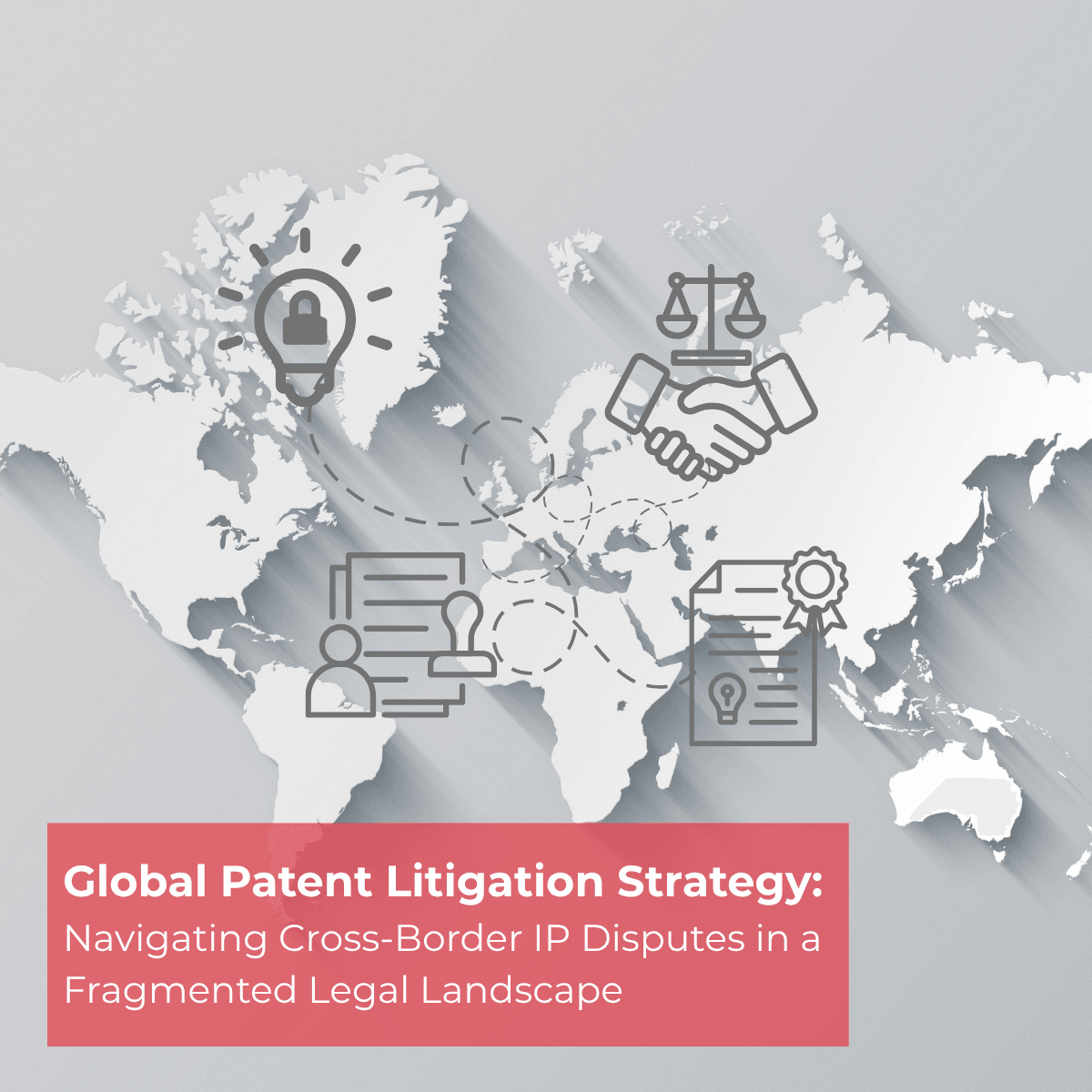
E. Kerim Yardımcı
Senior Partner
Global Patent Litigation Strategy: Navigating Cross-Border IP Disputes in a Fragmented Legal Landscape
Patents
31 July 2025
8 mins
In today’s fragmented IP landscape, companies must move beyond reactive tactics and develop comprehensive, forward-looking enforcement strategies.
Cross-functional alignment between legal, technical, and business teams is essential for resilient and strategic IP defense.
Key Takeaways
As intellectual property (IP) continues to shape competitive advantage in an increasingly knowledge-driven economy, patent litigation has grown in both complexity and global scope. Multinational companies are now required to navigate a diverse and often fragmented legal landscape—where jurisdictional variance, regulatory evolution, and strategic enforcement tactics intersect. This article explores how businesses are adapting their litigation strategies to meet these challenges, offering insights into proactive risk reduction, cross-border coordination, and the integration of patents with broader IP rights. The aim is to equip legal professionals with a forward-looking perspective on how to manage and leverage patent disputes in today’s interconnected global environment.
Evolving Enforcement Strategies
In light of the increasingly complex global IP litigation environment, where developing a global patent litigation strategy has become essential, multinational companies are under growing pressure to reassess and refine their patent enforcement strategies. In connection with the trends outlined at the outset—the emergence of IP specialty courts, the implementation of the Unified Patent Court (UPC), and the heightened strategic importance of intellectual property—it has become clear that traditional enforcement models no longer suffice. Patent holders are now operating in a landscape marked by greater jurisdictional diversity, procedural variability, and strategic nuance. This evolving reality necessitates a shift in perspective: toward more integrated, forward-looking enforcement frameworks that can accommodate the demands of a fragmented yet increasingly interconnected IP ecosystem.
Types of Patent Disputes Today
Today’s global patent landscape presents companies with a rising tide of international patent disputes with an increasingly diverse and sophisticated spectrum of disputes. From cross-border infringement and parallel litigation to standard-essential patents (SEPs) and FRAND-related conflicts, businesses must now contend with challenges that span legal, technical, and commercial dimensions. This evolution in dispute typology reflects not only the growing value of IP assets but also the complexity of enforcing them in a fragmented legal environment. As such, companies are compelled to develop more adapted, jurisdiction-aware enforcement and risk mitigation strategies for every step.
Proactive Risk Reduction
Given the high costs, delays, and unpredictability often associated with global patent disputes, companies cannot afford to be reactive. Particularly when entering new markets or launching new products, it is imperative that patent-related risks are addressed through structured patent risk management strategies from the outset through a structured and forward-thinking approach.
Several foundational steps can significantly reduce exposure to litigation:
- Systematic invention harvesting and the strategic development of patent portfolios aligned with core business objectives,
- Comprehensive review of contractual arrangements, including ownership and assignment of IP rights, to eliminate ambiguity,
- Proactive negotiation of licenses or cross-licenses that can prevent future conflict and open opportunities for collaboration.
Collectively, these measures help build a more resilient IP posture—transforming patent risk into a source of strategic advantage.
Freedom-to-Operate as a Strategic Tool
Freedom-to-operate (FTO) analysis is one of the most effective tools for identifying and avoiding potential infringement risks—but only when applied as a dynamic, ongoing process rather than a static, one-off assessment. To yield meaningful value, FTO must be embedded early in the product lifecycle and continuously revisited as designs evolve, markets shift, or new jurisdictions come into focus.
A robust FTO strategy is anchored in three key principles:
- Early and systematic integration of FTO reviews into product development roadmaps,
- Iterative application of FTO as products evolve,
- Cross-functional collaboration between R&D, legal, and business stakeholders.
This adaptive, cross-disciplinary approach to FTO enables companies to move confidently through complex IP landscapes, supporting both legal defensibility and strategic growth.
Structuring Litigation Teams
Effective patent litigation management demands a well-structured in-house legal function and seamless coordination with external counsel. To navigate complex, high-stakes disputes, companies must ensure that internal legal teams are not only equipped with IP-specific expertise but are also embedded within cross-functional decision-making processes.
Successful litigation strategies require alignment between legal, R&D, product, and executive teams. External counsel brings jurisdiction-specific expertise and litigation experience, while in-house teams provide strategic continuity and deep business knowledge. When structured effectively, this collaboration—especially when driven by teams seasoned in international IP dispute management—enables businesses to respond decisively while maintaining control over legal strategy and risk exposure.
Beyond Patents: A Broader IP Strategy
A truly effective IP enforcement strategy requires broadening the focus beyond patents alone. While patents frequently serve as the anchor in litigation, they are often just one facet of a more comprehensive intellectual property framework. In practice, many disputes—and especially coordinated enforcement campaigns—draw on a combination of IP rights to maximize leverage and legal efficacy.
This often includes:
- Trademarks, which safeguard brand identity and consumer trust,
- Design rights, offering swift protection for product aesthetics,
- Trade secrets, which preserve the confidentiality of valuable technical or commercial information.
Integrating these rights into a unified enforcement strategy diversifies legal tools and reflects the approach typically taken by professionals with comprehensive IP litigation expertise and enhances resilience across different markets and enforcement venues.
Cross-Border Litigation Strategy
Navigating cross-border patent disputes has become an essential competency in cross-border IP enforcement efforts for globally active companies. Litigation is rarely confined to a single jurisdiction—particularly when competitors operate across markets, product lines are globally distributed, or standards have international application.
To manage these complexities, companies must coordinate litigation efforts across multiple jurisdictions. Legal teams with significant experience in cross-border IP enforcement are particularly well-positioned to navigate these dynamics and advise clients effectively, each with its own legal frameworks, procedural nuances, and timelines. Jurisdictional choice plays a pivotal role in shaping litigation outcomes. The decision of where to initiate—or defend against—litigation can influence remedies, speed, evidentiary thresholds, and enforcement opportunities. A well-informed forum selection strategy—guided by practitioners familiar with the litigation climates of key jurisdictions—enables stronger outcomes across a fragmented but interconnected enforcement landscape.
Practical Tip
- Companies entering new markets should conduct jurisdiction-specific FTO analyses
- Review existing IP agreements before launching.
- Preemptive license negotiations can reduce dispute risk and reveal strategic collaboration opportunities.
Conclusion
In an increasingly fragmented and fast-moving global IP landscape, companies must move beyond reactive enforcement models and embrace a more strategic, integrated approach to patent litigation. This includes early planning, cross-functional coordination, and a nuanced understanding of how different jurisdictions can influence both legal outcomes and business impact.
The most effective enforcement strategies today prioritize strong patent portfolios, incorporate complementary IP rights, anticipate cross-border complexities, and align legal tactics with broader commercial objectives. As global patent disputes grow in scope and sophistication, success will depend on a company’s ability to navigate this environment with foresight, agility, and alignment across teams.

Deriş Patent Building Kabataş, İstanbul
+90 212 252 6122
© 2025 Deriş. All rights reserved.
© Madde22. All rights reserved